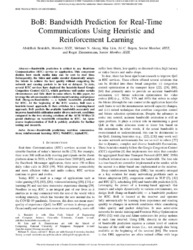BoB: Bandwidth prediction for real-time communications using heuristic and reinforcement learning
| dc.contributor.author | Bentaleb, A. | |
| dc.contributor.author | Akçay, Mehmet Necmettin | |
| dc.contributor.author | Lim, M. | |
| dc.contributor.author | Beğen, Ali Cengiz | |
| dc.contributor.author | Zimmermann, R. | |
| dc.date.accessioned | 2023-08-09T11:35:51Z | |
| dc.date.available | 2023-08-09T11:35:51Z | |
| dc.date.issued | 2023 | |
| dc.identifier.issn | 1520-9210 | en_US |
| dc.identifier.uri | http://hdl.handle.net/10679/8614 | |
| dc.identifier.uri | https://ieeexplore.ieee.org/document/9926128 | |
| dc.description.abstract | Bandwidth prediction is critical in any Real-time Communication (RTC) service or application. This component decides how much media data can be sent in real time. Subsequently, the video and audio encoder dynamically adapts the bitrate to achieve the best quality without congesting the network and causing packets to be lost or delayed. To date, several RTC services have deployed the heuristic-based Google Congestion Control (GCC), which performs well under certain circumstances and falls short in some others. In this paper, we leverage the advancements in reinforcement learning and propose BoB (Bang-on-Bandwidth) — a hybrid bandwidth predictor for RTC. At the beginning of the RTC session, BoB uses a heuristic-based approach. It then switches to a learning-based approach. BoB predicts the available bandwidth accurately and improves bandwidth utilization under diverse network conditions compared to the two winning solutions of the ACM MMSys'21 grand challenge on bandwidth estimation in RTC. An open-source implementation of BoB is publicly available for further testing and research. | en_US |
| dc.language.iso | eng | en_US |
| dc.publisher | IEEE | en_US |
| dc.relation.ispartof | IEEE Transactions on Multimedia | |
| dc.rights | Attribution 4.0 International | * |
| dc.rights | openAccess | |
| dc.rights.uri | http://creativecommons.org/licenses/by/4.0/ | * |
| dc.title | BoB: Bandwidth prediction for real-time communications using heuristic and reinforcement learning | en_US |
| dc.type | Article | en_US |
| dc.description.version | Publisher version | en_US |
| dc.peerreviewed | yes | en_US |
| dc.publicationstatus | Published | en_US |
| dc.contributor.department | Özyeğin University | |
| dc.contributor.authorID | (ORCID 0000-0002-0835-3017 & YÖK ID 217660) Beğen, Ali | |
| dc.contributor.ozuauthor | Beğen, Ali Cengiz | |
| dc.identifier.volume | 25 | |
| dc.identifier.startpage | 6930 | en_US |
| dc.identifier.endpage | 6945 | en_US |
| dc.identifier.wos | WOS:001133278300003 | |
| dc.identifier.doi | 10.1109/TMM.2022.3216456 | en_US |
| dc.subject.keywords | AlphaRTC | en_US |
| dc.subject.keywords | Bandwidth | en_US |
| dc.subject.keywords | Bandwidth prediction | en_US |
| dc.subject.keywords | Bit rate | en_US |
| dc.subject.keywords | Estimation | en_US |
| dc.subject.keywords | Optimization | en_US |
| dc.subject.keywords | Prediction algorithms | en_US |
| dc.subject.keywords | Quality of experience | en_US |
| dc.subject.keywords | Real-time communications | en_US |
| dc.subject.keywords | Reinforcement learning | en_US |
| dc.subject.keywords | RTC | en_US |
| dc.subject.keywords | Streaming media | en_US |
| dc.subject.keywords | WebRTC | en_US |
| dc.identifier.scopus | SCOPUS:2-s2.0-85140709165 | |
| dc.contributor.ozugradstudent | Akçay, Mehmet Necmettin | |
| dc.relation.publicationcategory | Article - International Refereed Journal - Institutional Academic Staff and PhD Student |
Files in this item
This item appears in the following Collection(s)
Share this page




